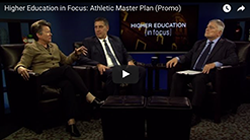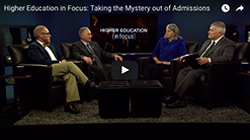President responds to Penn State community’s messages on Greek life
Dear Friends:
I now have more than 1,000 emails and letters sitting in my office providing advice on Greek life. The advice runs the full gamut – from insisting that it is time to shut the system down to stressing the long demonstrated value of maintaining the leadership qualities of Greek-life self-governance. Many say education is the only way to solve the problem, while others focus on stiff penalties. I am asked to firmly take immediate action and I am told that nothing will work if I don’t take the time to involve the broadest possible set of constituencies in each decision. And, although I have read the many communications, I simply cannot answer them all. But, I also realize that in the hard work over the last few months on this problem, I have not taken the opportunity to communicate what we have done and why. So, that is the purpose of this letter to you.
First, we have had extensive internal discussions on our options, which range from ending our recognition of Greek-letter organizations (we can remove our recognition but actually cannot shut them down as they are private organizations) to implementing a set of far-reaching comprehensive reforms. With the clear recognition that the safety of our students is paramount, the University administration believes that the only choice is to attempt to replace the current Greek self-governance model with much greater University control. The self-governance model that is prevalent across the nation is not working, and we must act in the interest of improving the safety and well-being of our students. I was extremely pleased that the Board of Trustees unanimously endorsed this option during their special meeting on June 2, held solely to discuss these options.
Second, the reforms endorsed by the board consisted of 15 action items. These items came from many sources including the Fraternity and Sorority Life Task Force, which consisted of a very broad set of constituencies, as well as national discussions on alcohol and hazing. Five of the 15 action items are viewed as critical:
- University control of the misconduct process for serious violations by removing it from the IFC and Panhellenic councils;
- Deferred rush so that students become established at Penn State academically and socially before joining a Greek organization;
- Zero tolerance for hazing involving alcohol and physical or mental abuse, where violations will result in swift permanent revocation of recognition;
- Significant reductions in the magnitude and frequency of social events, which can only be held if there are trained bartenders and only beer and wine is served; and
- Creation of an independent group to monitor and assess Greek-letter organizations with the capability to do much more frequent spot checks.
The full set of action items can be found on Penn State Update. Next, the University created a Greek-life Response Team (GRT). Some have viewed this as a task force or a group designed to discuss how to prevent hazing and excessive alcohol consumption. However, the GRT is designed to implement the action items endorsed by the Board and therefore consists of individuals (Thomas G. Poole, vice president for administration and chair of the response team; Damon Sims, vice president for Student Affairs; Zack Moore, vice president for Government and Community Relations; Keith Morris, chief, University Police and Public Safety; Frank T. Guadagnino, associate general counsel) who are directly responsible for employees assigned to develop the implementation strategies for one or more of the 15 tasks. For example, one of the action items is focused on our leadership in solving problems related to hazing, and consequently we will work to enable new legislation that increases the penalties for hazing. For that reason, the VP for Government and Community Relations will serve on the GRT as he has responsibility for federal and state lobbyists and interactions with local governments.
The GRT will also have a partner group, consisting of a dozen or more individuals who will review and react to the implementation plans for each action item. This group will be intentionally broad and representative, involving student leaders, members of sororities and fraternities, members of the Board of Trustees, various faculty and staff leaders, and alumni. This review group will be co-chaired by the vice president for Commonwealth Campuses and the vice provost for Educational Equity to ensure that any proposed implementation plan doesn’t have unintended consequences or miss any population of students. The co-chairs will serve on the GRT for that purpose. Following feedback and revision, it is then my intent to post the specific implementation plans.
It is important to understand that the University’s many student organizations provide unique learning opportunities that expand upon the rich learning experience found within the classrooms at Penn State. We value these organizations because they give our students the chance to practice their leadership and organizational skills, to take responsibility for outcomes, to build community, and to better understand what it means to be responsible for one’s self and for others. These opportunities are abundant within our Greek-letter organizations and we want students to own their experiences within these groups to the fullest extent possible. But until fundamental change is achieved within our Greek-letter community, the risk of relying on self-governance among these organizations is simply too great. The University must instead exercise a heavier hand in the oversight of these organizations and their activities, not because there is a desire to take responsibility from students, but because it must do so in the interest of their well-being, at least for now.
Our focus is here, within our own Greek-life community, but Penn State intends to lead others in this important dialogue and effort, too. These issues are national in scope, and to the extent we can lead the way in finding a better and more sustainable path for fraternities and sororities across the nation, we shall do just that.
I appreciate your many emails and letters, and I hope that I have provided you with a good sense of where we are going, why, and the many roles individuals will play in moving Penn State into a position where we can mitigate bad behavior and also protect the many positive values of Greek life.
Eric J. Barron
President, Penn State




